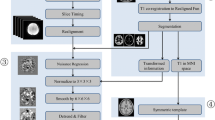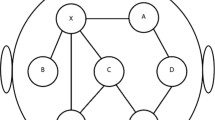Abstract
Sleep deprivation (SD) can alter the intrinsic brain functional organization. However, its effects on intrinsic low-frequency connectivity in the whole brain have not been well characterized. In this study, we used voxel-based functional connectivity density (FCD) analysis to investigate the effects of SD on the spontaneous functional organization of the brain. Thirty-seven healthy participants underwent this within-subject crossover functional magnetic resonance imaging (fMRI) study during rested wakefulness (RW) and after 36 h of total sleep deprivation (TSD). Decreased long-/short-range FCDs were observed in the posterior cingulate cortex, precuneus, inferior parietal lobule, dorsolateral prefrontal cortex, dorsomedial prefrontal cortex, and ventromedial prefrontal cortex. Increased long-/short-range FCDs were found in the sensory integration and arousal regulating areas, including the postcentral gyrus, thalamus, superior temporal gyrus, and occipital-temporal cortex. Moreover, a significant negative correlation was found between the short-range FCD of the PCC and the reaction time of Psychomotor Vigilance Task. In the present study, spontaneous functional organization with significant group-wise differences between RW and TSD sessions was identified. Our findings extend our understanding of the neural mechanism of how brain activity is altered in sleep-deprived individuals.



Similar content being viewed by others
References
Addis, D. R., McIntosh, A. R., Moscovitch, M., Crawley, A. P., & McAndrews, M. P. (2004). Characterizing spatial and temporal features of autobiographical memory retrieval networks: a partial least squares approach. Neuroimage, 23(4), 1460–1471.
Bembich, S., Clarici, A., Vecchiet, C., Baldassi, G., Cont, G., & Demarini, S. (2014). Differences in time course activation of dorsolateral prefrontal cortex associated with low or high risk choices in a gambling task. Frontiers in Human Neuroscience, 8, 464.
Ben Simon, E., Maron-Katz, A., Lahav, N., Shamir, R., & Hendler, T. (2017). Tired and misconnected: a breakdown of brain modularity following sleep deprivation. Human Brain Mapping, 38(6), 3300–3314.
Charroud, C., Steffener, J., Le Bars, E., Deverdun, J., Bonafe, A., Abdennour, M., et al. (2015). Working memory activation of neural networks in the elderly as a function of information processing phase and task complexity. Neurobiology of Learning and Memory, 125, 211–223.
Chee, M. W. L., Tan, J. C., Parimal, S., & Zagorodnov, V. (2010). Sleep deprivation and its effects on object-selective attention. NeuroImage, 49(2), 1903–1910. https://doi.org/10.1016/j.neuroimage.2009.08.067.
Chuah, Y. M. L., Venkatraman, V., Dinges, D. F., & Chee, M. W. L. (2006). The neural basis of interindividual variability in inhibitory efficiency after sleep deprivation. The Journal of Neuroscience: The Official Journal of the Society for Neuroscience, 26(27), 7156–7162. https://doi.org/10.1523/JNEUROSCI.0906-06.2006.
De Havas, J. A., Parimal, S., Soon, C. S., & Chee, M. W. L. (2012). Sleep deprivation reduces default mode network connectivity and anti-correlation during rest and task performance. NeuroImage, 59(2), 1745–1751. https://doi.org/10.1016/j.neuroimage.2011.08.026.
Drummond, S. P. A., Bischoff-Grethe, A., Dinges, D. F., Ayalon, L., Mednick, S. C., & Meloy, M. J. (2005). The neural basis of the psychomotor vigilance task. Sleep-New York Then Westchester-, 28(9), 1059.
Du Boisgueheneuc, F., Levy, R., Volle, E., Seassau, M., Duffau, H., Kinkingnehun, S., et al. (2006). Functions of the left superior frontal gyrus in humans: a lesion study. Brain, 129(12), 3315–3328.
Fransson, P., & Marrelec, G. (2008). The precuneus/posterior cingulate cortex plays a pivotal role in the default mode network: evidence from a partial correlation network analysis. Neuroimage, 42(3), 1178–1184.
Japee, S., Holiday, K., Satyshur, M. D., Mukai, I., & Ungerleider, L. G. (2015). A role of right middle frontal gyrus in reorienting of attention: a case study. Frontiers in Systems Neuroscience, 9, 23.
Kong, D., Asplund, C. L., & Chee, M. W. L. (2014). Sleep deprivation reduces the rate of rapid picture processing. Neuroimage, 91, 169–176.
Lei, Y., Shao, Y., Wang, L., Zhai, T., Zou, F., Ye, E., et al. (2015). Large-scale brain network coupling predicts total sleep deprivation effects on cognitive capacity. PLOS ONE, 10(7), e0133959. https://doi.org/10.1371/journal.pone.0133959.
Lei, Y., Wang, L., Chen, P., Li, Y., Han, W., Ge, M., et al. (2016). Neural correlates of increased risk-taking propensity in sleep-deprived people along with a changing risk level. Brain Imaging and Behavior. https://doi.org/10.1007/s11682-016-9658-7.
Liu, H., Li, H., Wang, Y., & Lei, X. (2014). Enhanced brain small-worldness after sleep deprivation: a compensatory effect. Journal of Sleep Research, 23(5), 554–563. https://doi.org/10.1111/jsr.12147.
Lundstrom, B. N., Ingvar, M., & Petersson, K. M. (2005). The role of precuneus and left inferior frontal cortex during source memory episodic retrieval. Neuroimage, 27(4), 824–834.
Menz, M. M., Buchel, C., & Peters, J. (2012). Sleep deprivation is associated with attenuated parametric valuation and control signals in the midbrain during value-based decision making. Journal of Neuroscience. https://doi.org/10.1523/JNEUROSCI.3553-11.2012.
Mu, Q., Mishory, A., Johnson, K. A., Nahas, Z., Kozel, F. A., Yamanaka, K., et al. (2005a). Decreased brain activation during a working memory task at rested baseline is associated with vulnerability to sleep deprivation. Sleep, 28(4), 433–446.
Mu, Q., Nahas, Z., Johnson, K. A., Yamanaka, K., Mishory, A., Koola, J., et al. (2005b). Decreased cortical response to verbal working memory following sleep deprivation. Sleep, 28, 55–67.
Murphy, K., & Fox, M. D. (2017). Towards a consensus regarding global signal regression for resting state functional connectivity MRI. NeuroImage, 154(2016), 169–173. https://doi.org/10.1016/j.neuroimage.2016.11.052.
Namni Goel, Rao, H., Durmer, J. S., Dinges, D. F. (2009). Neurocognitive consequences of sleep deprivation. 29(4), 320–339. https://doi.org/10.1055/s-0029-1237117.Neurocognitive.
Power, J. D., Barnes, K. A., Snyder, A. Z., Schlaggar, B. L., & Petersen, S. E. (2012). Spurious but systematic correlations in functional connectivity MRI networks arise from subject motion. NeuroImage, 59(3), 2142–2154. https://doi.org/10.1016/j.neuroimage.2011.10.018.
Qin, W., Xuan, Y., Liu, Y., Jiang, T., & Yu, C. (2015). Functional connectivity density in congenitally and late blind subjects. Cerebral Cortex, 25(9), 2507–2516. https://doi.org/10.1093/cercor/bhu051.
Raichle, M. E. (2015). The restless brain: how intrinsic activity organizes brain function. Philosophical Transactions of the Royal Society of London B: Biological Sciences, 370(1668), 20140172. https://doi.org/10.1098/rstb.2014.0172.
Raichle, M. E., MacLeod, A. M., Snyder, A. Z., Powers, W. J., Gusnard, D. A., & Shulman, G. L. (2001). A default mode of brain function. Proceedings of the National Academy of Sciences, 98(2), 676–682.
Sämann, P. G., Tully, C., Spoormaker, V. I., Wetter, T. C., Holsboer, F., Wehrle, R., & Czisch, M. (2010). Increased sleep pressure reduces resting state functional connectivity. Magma (New York, N.Y.), 23(5–6), 375–389. https://doi.org/10.1007/s10334-010-0213-z.
Schilling, C., Kühn, S., Paus, T., Romanowski, A., Banaschewski, T., Barbot, A., et al. (2013). Cortical thickness of superior frontal cortex predicts impulsiveness and perceptual reasoning in adolescence. Molecular Psychiatry, 18(5), 624–630.
Schmidt, M. H. (2014). The energy allocation function of sleep: a unifying theory of sleep, torpor, and continuous wakefulness. Neuroscience and Biobehavioral Reviews, 47C, 122–153. https://doi.org/10.1016/j.neubiorev.2014.08.001.
Simon, E. B., Oren, N., Sharon, H., Kirschner, A., Goldway, N., Okon-Singer, H., et al. (2015). Losing neutrality: the neural basis of impaired emotional control without sleep. Journal of Neuroscience, 35(38), 13194–13205. https://doi.org/10.1523/JNEUROSCI.1314-15.2015.
Thomas, M., Sing, H., Belenky, G., Holcomb, H., Mayberg, H., Dannals, R., et al. (2000). Neural basis of alertness and cognitive performance impairments during sleepiness. Journal of Sleep Research, 9(4), 335–352.
Thomas, M. L., Sing, H. C., Belenky, G., Holcomb, H. H., Mayberg, H. S., Dannals, R. F., et al. (2003). Neural basis of alertness and cognitive performance impairments during sleepiness. I. Effects of 24 h of sleep deprivation on waking human regional brain activity. Journal of Sleep Research, 9(4), 335–352.
Tomasi, D., & Volkow, N. D. (2010). Functional connectivity density mapping. Proceedings of the National Academy of Sciences of the United States of America, 107(21), 9885–9890. https://doi.org/10.1073/pnas.1001414107.
Tomasi, D., & Volkow, N. D. (2011a). Functional connectivity hubs in the human brain. NeuroImage, 57(3), 908–917. https://doi.org/10.1016/j.neuroimage.2011.05.024.
Tomasi, D., & Volkow, N. D. (2011b). Association between functional connectivity hubs and brain networks. Cerebral Cortex, 21(9), 2003–2013. https://doi.org/10.1093/cercor/bhq268.
Tomasi, D., & Volkow, N. D. (2012a). Abnormal functional connectivity in children with attention-deficit/hyperactivity disorder. Biological Psychiatry, 71(5), 443–450. https://doi.org/10.1016/j.biopsych.2011.11.003.
Tomasi, D., & Volkow, N. D. (2012b). Gender differences in brain functional connectivity density. Human Brain Mapping, 33(4), 849–860. https://doi.org/10.1002/hbm.21252.
Tomasi, D., & Volkow, N. D. (2012c). Laterality patterns of brain functional connectivity: gender effects. Cerebral Cortex (New York, N.Y.: 1991), 22(6), 1455–1462. https://doi.org/10.1093/cercor/bhr230.
Tomasi, D., Wang, R. L., Telang, F., Boronikolas, V., Jayne, M. C., Wang, G.-J., et al. (2009). Impairment of attentional networks after 1 night of sleep deprivation. Cerebral Cortex (New York, N.Y.: 1991), 19(1), 233–240. https://doi.org/10.1093/cercor/bhn073.
Tomasi, D., Shokri-Kojori, E., & Volkow, N. D. (2015). High-resolution functional connectivity density: hub locations, sensitivity, specificity,reproducibility, and reliability. Cerebral Cortex, 200, bhv171. https://doi.org/10.1093/cercor/bhv171.
Utevsky, A. V., Smith, D. V., & Huettel, S. A. (2014). Precuneus is a functional core of the default-mode network. The Journal of Neuroscience, 34(3), 932–940.
Wang, Y., Liu, H., Hitchman, G., & Lei, X. (2015). Module number of default mode network: inter-subject variability and effects of sleep deprivation. Brain Research, 1596, 69–78.
Wu, J. C., Gillin, J. C., Buchsbaum, M. S., & Hershey, T. (1991). The effect of sleep deprivation on cerebral glucose metabolic rate in normal humans assessed with positron emission tomography. Sleep: Journal of Sleep Research & Sleep Medicine.
Yeo, B. T. T., Tandi, J., & Chee, M. W. L. (2015). Functional connectivity during rested wakefulness predicts vulnerability to sleep deprivation. NeuroImage, 111, 147–158. https://doi.org/10.1016/j.neuroimage.2015.02.018.
Funding
This work was supported by the National Military Science Foundation of China, Nos. AWS12J003-2 (ZY), 2012ZX09031 (ZY); the National Key Technology R&D Program, No. 2013BAH02B00 (ZY).
Author information
Authors and Affiliations
Corresponding authors
Ethics declarations
Conflict of interest
None.
Ethical approval
All procedures performed in studies involving human participants were in accordance with the ethical standards of the institutional and/or national research committee and with the 1964 Helsinki declaration and its later amendments or comparable ethical standards.
Informed consent
Informed consent was obtained from all individual participants included in the study.
Rights and permissions
About this article
Cite this article
Yang, L., Lei, Y., Wang, L. et al. Abnormal functional connectivity density in sleep-deprived subjects. Brain Imaging and Behavior 12, 1650–1657 (2018). https://doi.org/10.1007/s11682-018-9829-9
Published:
Issue Date:
DOI: https://doi.org/10.1007/s11682-018-9829-9




